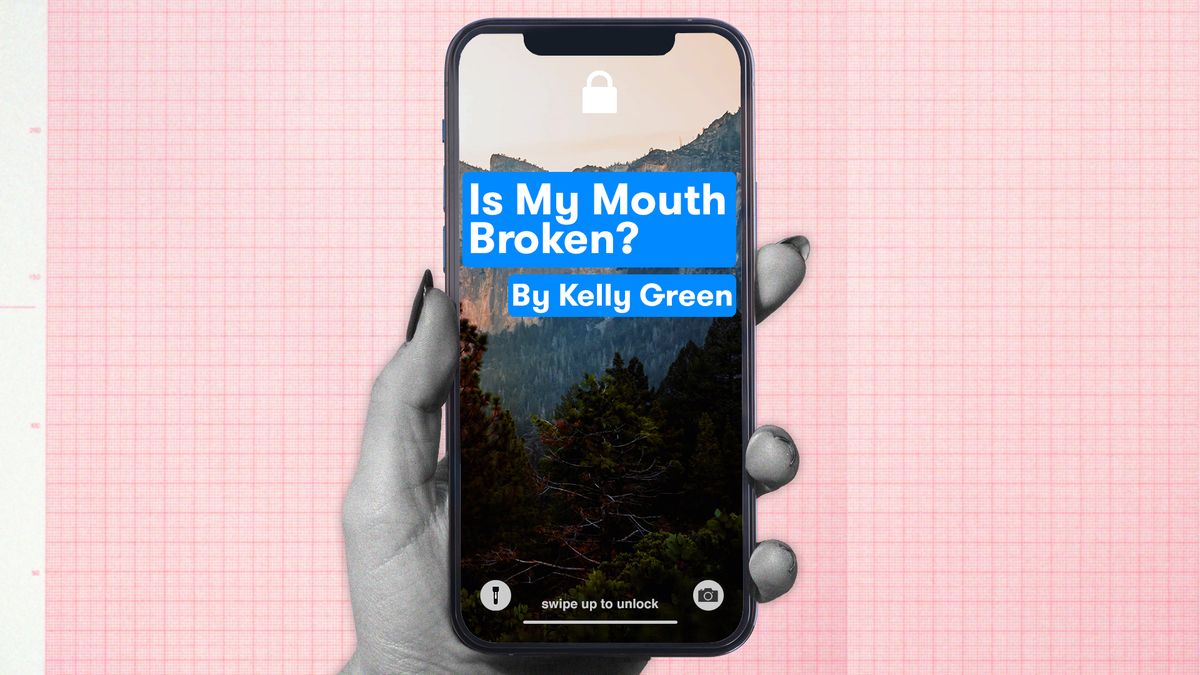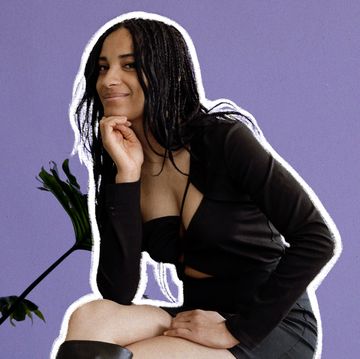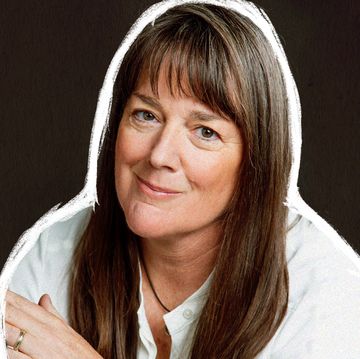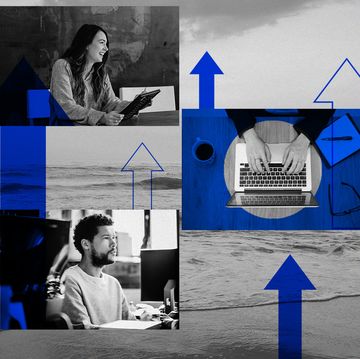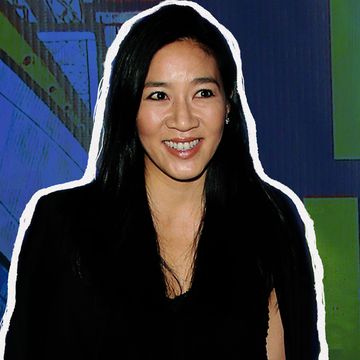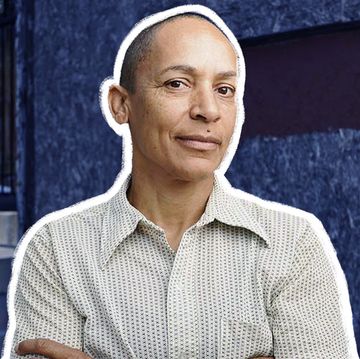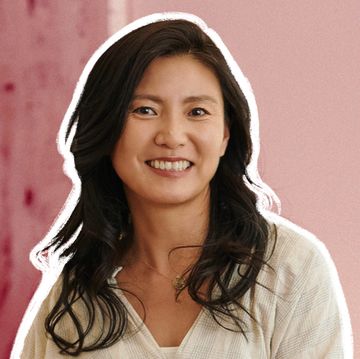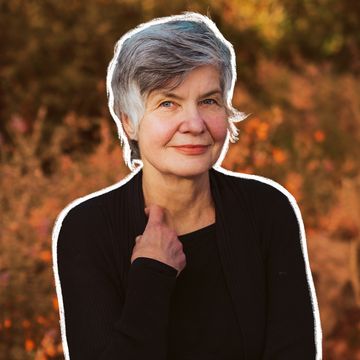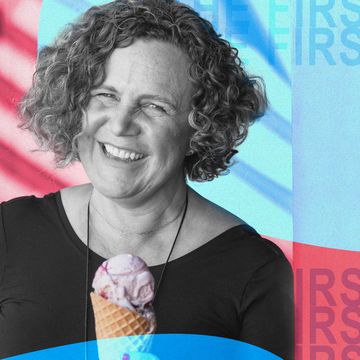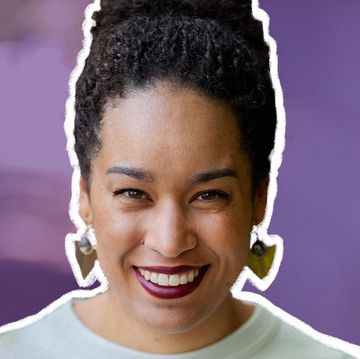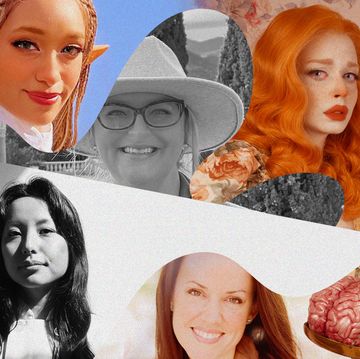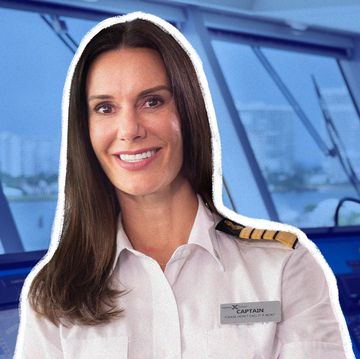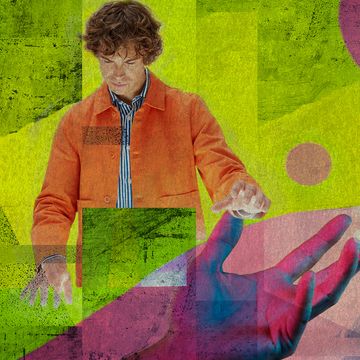As ubiquitous as horses have been throughout our world’s history, these days they can sometimes seem more like the province of Bridgerton-inspired fever dreams than an active part of modern life. Yes, we have modernized many elements of our existence and removed horses from their roles in transportation and agriculture and as subjects in popular paintings. For most of us, our equine contact is limited to the occasional trail ride or perhaps reading Black Beauty or The Saddle Club series as a kid.
However, those who love horses really love horses. And honestly, who can blame them? There’s something hypnotic about connecting with a large animal, whether it’s working together as you ride or just admiring its beauty as it gallops by. Which is why this month we’re exploring some of the unique subcultures of the horse world. From stunt horses and creative muses to healing pets and racing record-breakers, these animals and the women who nurture them are galloping into history.
Camilla Naprous, horse master and stunt coordinator
Camilla Naprous was born into the family business, and the stunt coordinator and horse master fell in love with her work early — and as she notes, it’s been a blessing. While many of her contemporaries have booked a handful of gigs in the last few years, she’s practically lived on sets across the United Kingdom, bringing with her the horses, equipment, and knowledge needed to achieve memorable scenes in films and TV series like Wonder Woman, Tolkien, and Game of Thrones while also earning a spot in the National Cowgirl Hall of Fame.
“I think I’ve lost count of how many [film and TV] credits I’m up to now,” Naprous says, fresh off a trail ride with Joaquin Phoenix, her riding student for the day.
While there’s always more to come, including an upcoming stint on the film Napoleon, and more she hopes to do (like work with director Jane Campion), Naprous is still delighted that she gets to go to work every day and do exactly what she was born to do — quite literally.
On joining Game of Thrones as the head horse master at 24
“That was an amazing opportunity for me and great because when Game of Thrones started, we didn’t really know what it was. I remember turning up for my first week, and I had no idea of the books or anything like that. And then, from where it started to where it ended, it was an incredible experience. David [Benioff] and Dan [D.B. Weiss] gave me lots of opportunities to be creative and bring in different ideas. I remember I was reading one of the outlines, the Dothraki battle later on with Jaime Lannister, and it was like, ‘We’re going to do this Dothraki attack.’ And then on the next line was just ‘Camilla, it’s up to you — do your thing. See what you bring to the table.’”
On training actors to ride
“I remember having my first canter with Olivia Colman. I think it’s my third time [working with her], and she always comes back and forth. She had this excitement like a child. It was really nice because doing something like that, you can see people when they go back to their childlike state, and it’s very rare in life as we become adults. We want to become adults very early on, but it turns out being an adult is not that easy. I think that’s nice for me to give memorable moments to other people, and to be able to be privy to it in such a vulnerable, private state.”
Why she never gets bored
“Each job might give you something different. It might be about a certain sequence. It might be about working with this incredible collaboration — you might end up with the best group of people ever. I feel like every time you finish one, you close a chapter; you open up a new chapter, we move forward. … Everybody’s different. Every horse is different. Every human is different. And everyone should respect that. With actors, we’ll have some light education, or we’ll just ride around the woods and walk, trot, and canter. It’s very much trying to go together as building this trust relationship. Because it’s a trust between the three of us: me as the trainer of the horse, the horse, and the person I’m going to meet, and then trusting the three of us on how the dynamic is going to work. And we’re going to have a very short amount of time to be able to create this bond.”
Katarzyna Okrzesik-Mikolajek, fine-art equine photographer
When Katarzyna Okrzesik-Mikolajek received her first camera as a teenager, she had one thing on her mind — horses. Her singular vision has served her well. The photographer, who now makes her home in both Canada and Poland, has traveled the world to capture otherworldly images of her favorite animal.
While her travels aren’t always for work — she admits that she can’t go anywhere without her camera and a strong desire to find horses — seeing the world through her lens has given her some incredible opportunities to learn about herself as she encounters new experiences in search of her favorite subject.
“We are very keen to judge other cultures,” says Okrzesik-Mikolajek, who boasts a bevy of awards for her work. “But I think being there and witnessing this and trying to understand really will make us wiser. I’m a totally different person because I started to see it that way.”
How horses accidentally expanded her world
“Once in Poland, I went to photograph a specific breed, a Gypsy horse with feathers on the legs. There are not many of them in Poland, so I went to that owner, and now she’s my sister-in-law. I married her brother! It’s a happy-ending story. Because of him, I went to England, and it introduced me to this [horse] community, and everything was so beautiful. And because of them, I fell in love so much with those horses that we decided to import some and start our own breeding program. And that’s why I have 20 horses together with my sister-in-law. So, that’s why I’m also able to travel so much, because she takes care of them. And I’m responsible for all the breeding programs because we were trying to breed really quality horses and export them abroad.”
The lengths she’s gone to in order to get the shot
“I think one of the most extreme conditions I have traveled in is in winter in Canada. Sometimes I photograph in a field in minus 40 degrees Celsius wind chill. There’s frostbite, and our cameras are freezing — but I think it also makes beautiful stories because you keep coming back with a nice picture and a story behind the picture. Sometimes it’s mind-blowing. … Whenever I have an opportunity to get dirty, I will just go for it because, in my mind, the adrenaline you’re getting is amazing. Even for me just being there with my camera and witnessing this moment is magical. Sometimes I don’t even have to work on those photos later on at home. Sometimes they just spend months in the folders.”
On the joy of community
“It’s a huge community. There’s thousands of equine photographers. But there’s always this kind of unhealthy competition between them. I organize events here in Poland, which are called ‘Big Gathering of Horse Photographers,’ which is about, first, bringing all the photographers together. And then we can all party together, making some beautiful connections and friendships as we’re photographing the same subjects and standing side by side. And the main purpose of that is to show that we all have different pictures in the same place. In the same moment, everyone has a different vision.”
Sue Miller, co-owner of Victory Gallop
Earlier this year, Sue Miller briefly went viral when The Kelly Clarkson show discovered that she and her therapy pony Willie Nelson were visiting kids at children’s hospitals in Akron, Ohio. While Miller enjoyed her 15 minutes of fame, the Victory Gallop co-owner sees her brush with stardom as part of a larger mission she’s been on for almost three decades: bringing the joy of horses to children and young adults with behavioral and/or emotional challenges, regardless of income.
“We now have 10 horses and the two minis, and we do 80 kids a week,” Miller says. “We just kept moving forward, and it’s been amazing. I really have been blessed: the people that have believed in us, the people that have supported us, the organizations in this area, the foundations, the individual people, and then the people that we have volunteer — it’s just such a family feeling at our farm.”
On the power of horses to emotionally heal
“It was hard to make friends in school because I just moved a lot, and you were always the outside kid. So, at the farm, I fit in. You find another girl, or kids that are arriving, and you just start competing, talking horses, and hanging out on the weekends. That was what my passion was, and where my friends and my relationships developed. And so, even if we would move, I could always take my horse, so I had somewhere to go that I still felt comfortable. It probably was very healing for me. I’ve always loved people and gotten along with anybody. When I went to school, there happened to be a program in therapeutic riding, and I got involved. Before I graduated from high school, I had my first job with the Metro Parks, starting a therapeutic riding program, and I never looked back.”
On her therapy horse Willie Nelson’s secret talent
“It’s really funny to me because he’s very businesslike. If you meet him at the barn, you’d be like, okay, he doesn’t have a lot of personality. He’s kind of dry. He has one goal in life, and that’s to eat. But you get him into the hospital, and he gets over to those beds, and he just bonds with the kids, and it’s just amazing. And it never gets old. People are like, ‘Do you ever get tired?’ I’m like, no, because you walk in that room, and just for those few minutes that kid is not thinking about how sick he or she feels. You know they’re going through a crappy time, and sometimes they feel really bad. We really understand that. We’ll just hang out; sometimes we’re there for a long time, and they just stroke and stroke the horse, and you can just tell it’s calming them, and we don’t even say two words.”
How her community has given back during Covid
“God just blesses us. We thought Covid was going to kill us and just shut us down because we had to cancel all of our fundraisers. But our sponsors and people have been more generous now. We tell people that if they want to make a non-money donation, you [can] always buy toilet paper, and paper towels, and computer paper, and carrots, and stuff like that. It’s very helpful. About two years ago, we also started a fitness program because we really found that we’ve done all sorts of different things with the kids. We have camps, and we’ve had craft nights, and we’ve had parent groups, and then tutoring, and we then do book clubs — you know, really incorporating other things besides the riding. And about three years ago, we started with Victory Athletics. We do run fitness programs as well for the kids to stay fit to ride. And so sometimes we have people donate water bottles, or healthy snacks, or workout equipment. So, it’s been amazing.”
Amy Beisel, director of the International Museum of the Horse
Amy M.M. Beisel describes her childhood growing up in Kentucky as idyllic — full of opportunities to interact with nature and ride horses. Although these days she considers herself more of a hobbyist when it comes to riding, when it came time to start a family, the museum director wanted her children to grow up with a similar experience. So, she accepted a position at the International Museum of the Horse. Not only does the museum offer exhibitions covering everything from Eadweard Muybridge’s first films featuring trotting horses to deep dives on horses through different cultures, but the property also houses barns where visitors can interact with a variety of horse breeds or even saddle up for a nominal fee. Ultimately, it’s a singular destination for anyone who is curious about the horse world but not sure where to begin.
On the biggest thing that she’s learned since taking on her job
“I enjoyed learning about the African American involvement in the history of horses in the United States. That’s been one of our largest exhibits we’ve opened since I’ve been here. And we’ve also been able to build a website from that as well. I think that’s been the biggest eye-opener for me, learning the history of what we know about horses, the racing aspect, the farming aspect, the evolution of the horse as a sport horse in the United States — it all very much came about because of the role of African Americans and the work that they’ve done in the horse industry. … We see a lot of really wonderful horse owners now that are really active in the horse industry, both in the thoroughbred industry and the pacer and trotter harness-racing industry as well. So, that’s been a huge learning experience to see how that’s evolved and how far we’ve come, and to really pay respect to the people who were left out of that history.”
On making the horse world accessible to those who can’t afford it
“Being in Kentucky, a lot of people own horses. It can be seen as a very white, elitist, expensive sort of hobby or profession. That’s something that we fight even here at the park, because horses are expensive to take care of. That’s one of the cool things about the park, that anybody can come in, no matter who you are or where you’re from, get close to a horse, and have an experience with the horse if that’s what you want. And it’s not out of reach. It doesn’t cost hundreds or thousands of dollars; it’s accessible. So, that’s been really nice to see that too. We’ve built a lot of really awesome community partners and community relationships from that, from that exhibit and from the website, from the advisers and the partners that we’ve reached out to, to help us learn more. It’s been a huge growth.”
What she hopes someone learns from their visit
“I would love for everybody to find something that they love in the museum, even if it’s not everything. I feel like there is something for everyone for whatever your interests may be in the museum. Horses were involved in so much of our history and so much of our lives that I feel like it’s relatable to anyone, even if you’re not a horse fanatic. I want everyone to feel welcome when they walk in our door. I want our visitors to come in and feel like even if they’re not the biggest equestrian or the most knowledgeable horse person, or maybe they know nothing at all, that they still feel welcome when they walk in the doors, that they still feel like they can access that information that we have, and that their questions can be answered. I don’t want anyone to feel intimidated or like it’s out of reach for them.”
Diane Crump, former jockey
In 1969, Diane Crump made history when she became the first female jockey to take part in a pari-mutuel race in the U.S. After a year and 40 wins later, she’d go on to become the first female jockey to ride in the Kentucky Derby. Even after her multiple history-book entries, she notes that it still took time for the industry to catch up.
“The hardest part of my career is that no matter how hard I worked, or how hard I tried, I was very limited in the mounts I could get,” she notes. “That was my biggest frustration. But, you know, I still loved it, and I don’t regret it.”
But even now, after a 30-year career, Crump looks back on her time in the saddle fondly. She prefers to credit God for her successes, as well as her parents, who were supportive despite not being horse people themselves. And while chronic pain prevents her from riding anymore, she’s found joy in a new career selling horses. Because, as she notes, loving horses is something that never goes away.
On her single-minded fascination with horses from an early age
“I believe that God puts something in your heart that you love. And I just think that he put horses in my heart. I loved it. I grew up with it. Everything I did revolved around horses or animals. My parents promised me that one day we were going to move to Florida and I could get a horse. From that day on, I started saving money. I think I was 8 years old when I got my first paper route. And I delivered papers, I did odd jobs in the summer, I mowed lawns, I babysat. I was just consumed by saving.”
On staying cool when men didn’t want her racing with them during her first race in 1969
“There was a jockey store that was right next to Hialeah racetrack. So, I went over there and got what I needed. And one of the jockeys, a friend of mine, said, ‘Hey, look, I’ll loan you the saddle just in case it doesn’t work out.’ So, he loaned me a saddle, and I went and bought the pants and the boots. I already had the helmet from training. But I had to get goggles, and, you know, everything else I needed. But the stewards had already laid down the law. They said all riders were riding. ‘This is Hialeah, and we will not put up with any boycotts at our racetrack.’ They said you will have a $2,500 fine, and you will be suspended for the meet if you refuse to ride against a woman. I just didn’t pay attention. I was gonna ride. This was my opportunity. This was what I lived and breathed, and I was going to ride, and I was so grateful that it was happening that I did not care what anybody had to say about it.”
On seeing the industry become more accepting of women riders
“If you’re capable, at least you have that opportunity. You can get mounts; you don’t have to fight as hard. There are some good women riders in this day and age. Tampa is where I came around. I loved it. It was my home. My family was there. The first time I rode, my dressing room was a ladies’ room in the grandstand. When I came back, they bought this little, teeny-weeny trailer, and they put it in the parking lot right next to the jocks’ room. But I came back 30 years later as I was wrapping up my career, and the jockeys’ room was enlarged. Downstairs was men, the upstairs was women, and if you looked at the program, the jockeys riding there were 50 percent women and 50 percent men. It was so nice.”
Laura Studarus is a Los Angeles-based travel writer with bylines at Fast Company, BBC Travel, and Thrillist. Sometimes she can go several hours without a cup of tea. Follow her adventures on Twitter.
Get Shondaland directly in your inbox: SUBSCRIBE TODAY







